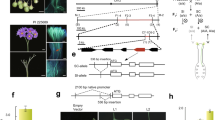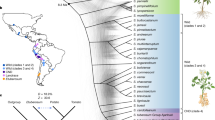Abstract
SPECIES of Solanum belonging to the section Tuberarium and occurring in Mexico have long been of interest to potato breeders, as several of them possess resistance to the late-blight caused by Phytophthora infestans de Bary. Like the tuberbearing species of Solanum found in South America, the Mexican species also form a polyploid series comprising diploids (2n = 24), triploids (2n = 36), tetra-ploids (2n = 48), pentaploids (2n= 60) and hexa-ploids (2n = 72). These species have been classified in eight distinct taxonomic series, and our information concerning the cytogenetic affinities among them is still very fragmentary. As a preliminary towards gathering such data, a systematic survey of ability to cross among the diploid species occurring in Mexico was undertaken by me, during the summer of 1953, at the Inter-regional Potato Introduction Station, Sturgeon Bay, Wisconsin.
This is a preview of subscription content, access via your institution
Access options
Subscribe to this journal
Receive 51 print issues and online access
$199.00 per year
only $3.90 per issue
Buy this article
- Purchase on Springer Link
- Instant access to full article PDF
Prices may be subject to local taxes which are calculated during checkout
Similar content being viewed by others
References
Swaminathan, M. S., and Howard, H. W., Bibliographia Genetica 16, 1 (1953).
Niederhauser, J. S., and Mills, W. R., Phytopath., 43, 456 (1953).
Author information
Authors and Affiliations
Rights and permissions
About this article
Cite this article
SWAMINATHAN, M. Overcoming Cross-Incompatibility among some Mexican Diploid Species of Solanum . Nature 176, 887–888 (1955). https://doi.org/10.1038/176887b0
Issue Date:
DOI: https://doi.org/10.1038/176887b0
This article is cited by
-
Role of Genetic Modification in Developing Climate Smart Agriculture to Ensure Sustained Food Security
Agricultural Research (2012)
-
Interspecific somatic hybridization betweenSolanum tuberosum L. andS. bulbocastanum dun. as a means of transferring nematode resistance
American Potato Journal (1993)
-
Hybridization between Gp. Tuberosum Haploids and 1EBN wild potato species
American Potato Journal (1991)
-
Crossability of some green-peach-aphid-resistant tuber-bearing solanums, potential bridging species, andSolanum tuberosum ssptuberosum
American Potato Journal (1977)
-
Studies on the possibility of transferring the self-compatibility complex of self-compatibleSolanum species to self-incompatible diploid breeding stocks. 1.S. polyadenium as the source of self-compatibility
Potato Research (1976)
Comments
By submitting a comment you agree to abide by our Terms and Community Guidelines. If you find something abusive or that does not comply with our terms or guidelines please flag it as inappropriate.



